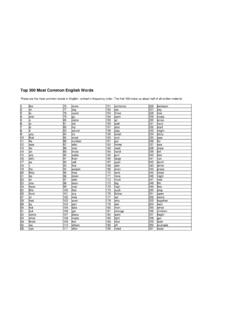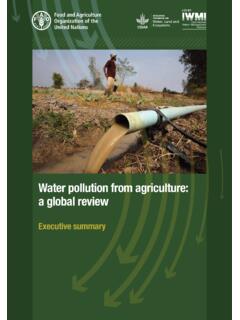Transcription of Hepatitis A Transmitted by Food - Centers for Disease ...
1 INVITED ARTICLE food SAFETY David Acheson, Section Editor Received 12 June 2003; accepted 1 October 2003; electronically published 11 February 2004. Reprints or correspondence: Anthony E. Fiore, Div. of Viral Hepatitis , Centers for Disease Control and Prevention, Atlanta, GA 30333 Clinical Infectious Diseases 2004; 38:705 15 This article is in the public domain, and no copyright is claimed. 1058-4838/2004/3805-0015 Hepatitis A Transmitted by food Anthony E. Fiore Division of Viral Hepatitis , Centers for Disease Control and Prevention, Atlanta Hepatitis A is caused by Hepatitis A virus (HAV). Transmission occurs by the fecal-oral route, either by direct contact with an HAV-infected person or by ingestion of HAV-contaminated food or water. Foodborne or waterborne Hepatitis A outbreaks are relatively uncommon in the United States. However, food handlers with Hepatitis A are frequently identified, and evaluation of the need for immunoprophylaxis and implementation of control measures are a considerable burden on public health resources.
2 In addition, HAV-contaminated food may be the source of Hepatitis A for an unknown proportion of persons whose source of infection is not identified. FEATURES OF Hepatitis A Hepatitis A virus (HAV) is classified as a picornavirus. Primates are the only natural host [1]. There is only 1 HAV serotype, and immunity after infection is lifelong [2]. After ingestion, uptake in the gastrointestinal tract, and subsequent replication in the liver, HAV is excreted in bile, and high concentrations are found in stool specimens. Transmission occurs by the fecal-oral route, either by direct contact with an HAV-infected person or by ingestion of HAV-contaminated food or water. The me dian incubation period ( , time from exposure to onset of symptoms) is 28 days (range, 15 50 days) [3]. Peak infectivity occurs during the 2-week period that precedes the onset of jaundice and declines during the week after onset.
3 In persons without jaundice, peak infectivity likely occurs as serum alanine aminotransferase [ALT] concentrations increase. Viremia can be detected before the ALT concentration increases, and HAV RNA levels often remain detectable even after the ALT level has normalized and symptoms have resolved [4]. Asymptomatic or anicteric HAV infection without the clinical signs and symptoms of Hepatitis A is common in children, and !10% of children aged !6 years with HAV infection have jaun dice [5]. Clinical manifestations of symptomatic HAV infection vary from mild, anicteric illness to fulminant Hepatitis . Among young adults with HAV infection, 76% 97% have symptoms, and 40% 70% are jaundiced [6]. Children and occasionally young adults can also have inapparent infection, in which symptoms and elevation of ALT levels are absent but serocon version occurs [7]. Hepatitis A begins with symptoms such as fever, anorexia, nausea, vomiting, diarrhea, myalgia, and malaise.
4 Jaundice, dark-colored urine, or light-colored stools might be present at onset or might follow constitutional symptoms within a few days. Physical findings can include abdominal tenderness, he patomegaly, or splenomegaly [8]. For most persons, Hepatitis A lasts for several weeks. Relapsing symptoms, accompanied by renewed elevation of serum aminotransferase levels, occur in 10% of cases, and relapses might continue for as long as 6 months [9]. The overall case-fatality rate is , but it is among persons aged 50 years. Persons with underlying chronic liver Disease have an increased risk of death [10]. Serologic testing is necessary to distinguish Hepatitis A from other forms of viral Hepatitis . The serologic marker of acute HAV infection, IgM antibody to HAV (IgM anti-HAV), is de tectable 5 10 days before the onset of symptoms and usually decreases to undetectable concentrations within 6 months after recovery [10].
5 However, of patients with acute Hepatitis A had detectable IgM levels 1200 days after illness in one study [11]. The sensitivity and specificity of commercially available IgM anti-HAV tests is 195%, and these tests reliably distinguish Hepatitis A from other forms of Hepatitis [10]. However, in terpretation of a positive IgM anti-HAV test result is problem atic for persons with no symptoms or laboratory evidence of acute Hepatitis and no epidemiologic link to other cases. Total anti-HAV (IgG plus IgM) is detectable during illness, remains detectable indefinitely, and is a reliable indicator of immunity food SAFETY CID 2004:38 (1 March) 705 to HAV infection. Total anti-HAV can be used to determine susceptibility before giving immunoprophylaxis but is not oth erwise useful to clinicians. No specific treatment for Hepatitis A has been shown to be effective. Medications that are metabolized by the liver, in cluding non prescription medications (such as acetamino phen), should be used with caution or avoided during acute viral Hepatitis .
6 Hepatitis A rarely causes fulminant Hepatitis , but hospitalization and evaluation for liver transplantation is nec essary for patients with signs of liver failure, such as hepatic encephalopathy or coagulopathy. EPIDEMIOLOGY HAV is primarily Transmitted by the fecal-oral route, either by person-to-person contact or by ingestion of contaminated food or water. Transmission also occurs after exposure to HAV-contaminated blood or blood products, but not by exposure to saliva or urine. Asymptomatic and nonjaundiced HAV-in fected persons, especially children, are an important source of HAV transmission [12]. The incidence of Hepatitis A in the United States varies in a cyclical pattern, with large increases approximately every 10 years, followed by decreases to less than the previous baseline incidence (figure 1). Incidence rates in the western and south western United States have been consistently higher than in other regions of the United States.
7 From 1980 through 2001, an average of 25,000 cases each year were reported to the Cen ters for Disease Control and Prevention (CDC), but when cor rected for underreporting and asymptomatic infections, an es timated average of 263,000 HAV infections occurred per year [13]. On the basis of surveillance data, children aged 5 14 years historically have the highest incidence of Hepatitis A [14], al though the incidence of HAV infection is probably highest among those !5 years old [15]. Approximately one-third of the United States population has been previously infected with HAV, with higher seroprevalence with increasing age and among persons with lower household incomes or of Hispanic ethnicity [10]. Since 1999, the Hepatitis A incidence has decreased to historic lows in the United States [16] (CDC, unpublished data). Risk factors for infection among reported cases are shown in figure 2 [14]. Personal contact (usually among household contacts or sexual partners) is the most important reported risk factor.
8 Relatively few reported cases (2% 3% per year) are identified through routine surveillance as part of common source outbreaks of Disease Transmitted by food or water. How ever, some Hepatitis A transmission attributed to personal con tact or other risk factors is likely to have been foodborne, occurring when an HAV-infected person contaminated food eaten by others. The proportion of sporadic cases that might be from foodborne sources is unknown but could be consid erable; 50% of reported patients with Hepatitis A do not have an identified source of infection [10, 14]. In developing countries, HAV transmission often is unre cognized, because most residents acquire HAV infection during early childhood. It is interesting to note that, as hygiene im proves, the mean age of infected persons increases and the clinical manifestations of Hepatitis A are more often recognized, leading to an increase in the Hepatitis A incidence ( , symp tomatic HAV infection), even as the incidence of HAV infection (which is commonly asymptomatic or does not cause jaundice in young children) may be decreasing [17].
9 Foodborne out breaks of infection are uncommon in developing countries be cause of high levels of immunity in the resident population, but foodborne transmission to nonimmune travelers might be an important source of travel-associated Hepatitis A. CHARACTERISTICS OF FOODBORNE TRANSMISSION HAV contamination of a food product can occur at any point during cultivation, harvesting, processing, distribution, or prep aration. Recognizing foodborne transmission using routine sur veillance data may be difficult because (1) case patients may have difficulty recalling food histories during the 2 6 weeks before illness, (2) cases may accrue gradually or not be reported, (3) a food item may be focally contaminated, (4) some exposed persons have unrecognized HAV infection, (5) some exposed persons have preexisting immunity (from a previous infection or previous vaccination), (6) persons who acquire infection through contaminated food are not recognized amid an on going high incidence in the community, and (7) cases are geo graphically scattered over several public health jurisdictions.
10 Figure 1. Incidence of Hepatitis A, United States, 1952 2002. Data are from the National Notifiable Disease Surveillance System of the Centers for Disease Control and Prevention [16] ( Centers for Disease Control and Prevention, unpublished data). Data for 2002 are provisional. 706 CID 2004:38 (1 March) food SAFETY food SAFETY CID 2004:38 (1 March) 707 Figure 2. Reported risk factors among persons with Hepatitis A, United States, 1990 2000. Data are from the Viral Hepatitis Surveillance Program, Centers for Disease Control and Prevention [14]. IDU, injection drug use; MSM, men who have sex with men. Transmission due to contamination of food at the point of sale or service. The source of most reported foodborne hep atitis A outbreaks has been HAV-infected food handlers present at the point of sale (such as in a restaurant) or who prepare food for social events (such as a wedding).














